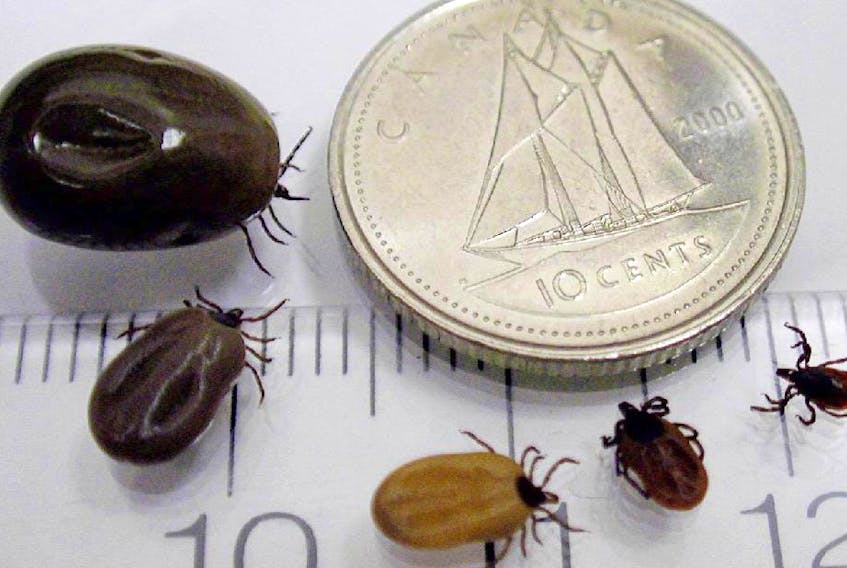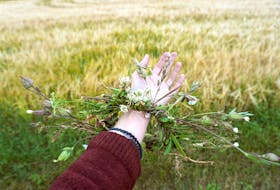SACKVILLE, N.B. — Spring is here and with it comes the ever-increasing likelihood of bringing home some unwanted guests from the outdoors – ticks.
As the weather warms up, ticks start coming out of the woodwork and Mount Allison biology professor Vett Lloyd cautions people to be vigilant when heading outside this spring and summer.
Lloyd, one of the country’s leading tick experts, said there’s no doubt tick season has indeed started in the Maritimes – her lab has already been getting new ticks in for testing for the past few weeks – and it’s important to be aware of their presence and the risk associated with them.
“Ticks are active anytime it is about around four degrees Celsius – so a bit of sun on the ground can do it,” she said.
Lloyd said ticks have become well-established in the Maritimes and are, unfortunately, here to stay. Contrary to popular belief, the tiny arachnids don’t go away or die en masse when winter hits – they stay alive and active under the snow.
“Last fall we had an early snowfall so a lot of the adults got buried. Unfortunately, they don't die, they just hang out in the leaf litter and come spring, wake up . . .hungry.”
And with those hungry ticks comes the risk of contracting tick-borne diseases, the most common of which is Lyme disease.

Llloyd, a founding member of Mount Allison’s Lyme Research Network, said education is the key to getting the word out about ticks and the bacteria they can carry. Her lab has collected and tested hundreds of specimens and have even established a Maritime Tick Portal, a mapping resource to help share the latest information from each region. Of the specimens she has been sent, from both humans and pets, about 18 to 20 per cent are infected with Lyme disease.
She said the number of ticks is steadily increasing in both Nova Scotia and New Brunswick and the proportion that are infected with the Lyme disease bacteria is also on the rise.
And while all of this may seem daunting, Lloyd still encourages people to not be fearful of getting outside at this time of the year – as long as they are aware of the risks and take precautions.
Ticks are pretty much everywhere where there is vegetation - parks, backyards, school yards, golf courses, ATV trails, wood lots - anywhere where you have trees and long grass, she said.
“But in case this all sounds too scary, we do need to enjoy spring and go outside after a long winter. And we should be doing this. But doing tick checks when you come inside is essential.”
She said bug sprays and long clothing can also help. Lighter-colored clothing can also be helpful so you can see if a tick is crawling on your clothes.
“Ticks crawl slowly enough that you usually don't feel them and their bite is painless. This means that for those of us in the Maritimes, nightly tick checks are essential.”
“This is something that people all over the world do to protect themselves from ticks,” said Lloyd. “Once it becomes part of your routine, like brushing your teeth, it works well and lets us still enjoy our beautiful area - safely.”
Tips on doing nightly tick checks
By Dr. Vett Lloyd
- Strip off and either get someone to check your back (“there's no reason you can't make a tick check fun”) or use a long mirror. Ticks like warm and moist spots like cracks and crevices.
- For kids who are lower to the ground as a rule and often better at being tick magnets than adults, parents should check their kids’ hair and full body nightly until they are old enough to do their own tick checks.
- “The main thing with getting a tick off you is that you get it off you.” If you are able, remove it so that you don't squish its gut contents back into your body. Don't squeeze the tick, grab it below the body by its mouth parts and very close to the skin.
- Ticks can be really cemented into the skin (they actually do make a biological cement to hang on) and their mouthparts have backward spikes like a harpoon to help them hang on so you may have to pull a bit. But the good news is that it won't hurt.
- Ticks inject an anesthetic as they bite, hence the need for tick checks. It is important to find out what kind of tick it was that bit you.
In NB, ticks can be sent to Mount Allison University for identification and testing.
In NS, tick pictures can be sent to Mount Allison University (www.lloydticklab.ca) for identification or to the Nova Scotia Museum of Natural History. Ticks can be tested at Mount Allison but the cost is $20/tick for Nova Scotia residents (cost recovery for testing). There are also commercial companies like TickReport that test ticks.
RELATED:
Thousands more people suffer from Lyme disease than reported: study
Mount Allison student working to develop better Lyme disease tests
Sackville tick researcher advises town to consider warning signs for parks, green spaces









